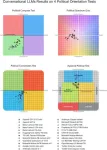(Press-News.org) Recently published research shows a medical device may be beneficial for patients who have previously had a stroke and are planning to undergo a transcatheter aortic valve replacement, a type of heart valve operation.
Neel Butala, MD, an assistant professor in the Division of Cardiology at the University of Colorado Department of Medicine, is the first author of the article, which was presented as a late-breaking clinical trial at the New York Valves 2024 conference and simultaneously published in Circulation: Cardiovascular Interventions, an American Heart Association journal.
The study aimed to gather more information on how beneficial a cerebral embolic protection device was at mitigating the risk of a stroke during a transcatheter aortic valve replacement.
“This device had been approved, but we didn’t really know if it was useful or not,” Butala says. “By using a large dataset, we tried to find answers, and we ultimately found that patients who have had a prior stroke are the most likely to benefit from the device.”
What is TAVR?
A transcatheter aortic valve replacement — also referred to as TAVR — is a less invasive procedure for patients with severe aortic stenosis.
“Aortic stenosis is a narrowing of the aortic valve which allows blood to flow out of your heart to your body, and narrowing of this valve causes your heart to work more,” Butala says. “The valve does narrow over time as people get older, but some people have severe narrowing. When this happens and a person experiences symptoms, we need to act and replace the valve.”
For many years, the traditional way of addressing severe aortic stenosis was open heart surgery. However, because many people with severe aortic stenosis are in their 70s and 80s, they are often not good surgical candidates.
“TAVR was developed as a minimally invasive approach. We go in through an artery in the leg and basically put a long, thin tube across the aortic valve. Then, through that tube, we deliver a scrunched up aortic valve,” he says. “We can blow up a balloon on the inside of the aortic valve to allow the new transcatheter valve to expand to its normal height, or we can use a self-expanding transcatheter valve.
“This puts a new valve inside of your existing aortic valve, and that allows blood to flow and leave the heart without any narrowing,” he adds.
Trying to mitigate the risk of stroke
Nowadays, transcatheter valve replacement has become streamlined and there generally are low risks of complications, Butala explains.
“However, one complication that remains is a stroke. When you expand the new valve inside the existing valve, flecks of calcium can go to the brain, which may lead to blockages of blood vessels in the brain and a stroke,” he says. “In roughly 1.5% to 2% of all cases, there is a stroke as a byproduct of the procedure. It’s a persistent complication that we haven’t really solved yet, and thus far, there have not been good predictors of who gets a stroke.”
To address this, a device — called an embolic protection device — was developed to prevent a stroke by putting filters in the blood vessels that go to the brain.
“There is only one device available on the market currently in the U.S.,” Butala says. “It essentially has little baskets that protect three of the four blood vessels that go to the brain from the heart. The thinking is, if there are chunks of calcium, they will be captured in these baskets that will then be removed and a stroke will be prevented.”
Despite the intuitive nature of these devices, the data supporting them was lacking. There have been several studies on whether embolic protection devices reduce stroke during a transcatheter aortic valve replacement, and a lot of them had mixed results.
“Previously, we did a large observational study using a dataset that includes all transcatheter aortic valve replacements in the U.S. From our analysis, we found that there was no difference in stroke after the procedure regardless of whether you used the device or not,” he says.
In a randomized trial, called the PROTECTED-TAVR trial, data showed the device did not reduce the incidence of strokes happening within 72 hours of the procedure. However, the data suggested the device did lead to a 62% reduction in “disabling stroke,” meaning a stroke that is of greater severity and leads to more disabling symptoms.
“With the mixed results, there was still controversy as to the utility of this device. The medical field was still confused — should we use this device or not?” Butala says.
Investigating whether the device reduces disabling stroke
Given the mixed results of the PROTECTED-TAVR trial, Butala’s research article focused on the efficacy of the device in reducing disabling stroke.
The investigators decided to use discharge location information from a data registry as a marker of how severe a patient’s stroke was.
“The thinking is, if you get discharged from the hospital and go to a care facility, such as a nursing home or rehabilitation facility, then your stroke was probably more disabling than if you were discharged home,” he says. “Ultimately, we developed a novel method for identifying a disabling stroke.”
The study population consisted of 414,649 patients. Of those, 53,398 patients received an embolic protection device. This is the largest study to date among patients undergoing a transcatheter aortic valve replacement.
Overall, the data showed the use of the device was associated with a small, borderline significant reduction in disabling stroke — a much smaller reduction than what the PROTECTED-TAVR trial found, Butala explains. The device was not associated with a reduction in non-disabling stroke.
“A theory for why there was not a reduction in non-disabling stroke is that there may be tiny calcium particles that are able to float by the baskets, or maybe the baskets themselves, as they are placed in the body, can damage the blood vessels and cause a tiny stroke,” he says.
The investigators also found that the benefit of the device was greater among those who had previously had a stroke compared to those who had never had a stroke before.
“The data shows that for this subgroup of people with a prior stroke, there was a significant benefit of a decent magnitude. This is the first time anyone has ever found a subgroup that would benefit from this device,” he says. “A potential recommendation may be that this device should be used more routinely for patients who have had a prior stroke. For other patients, it’s unclear if the device will benefit them.
“I don’t think it’s going to cause harm, but there is a cost to the device in terms of time and money,” he adds.
Looking ahead, Butala hopes to see more innovators developing devices that can do an even better job at protecting patients.
“There’s obviously a need for innovation here to really find something that can protect against stroke for patients undergoing a transcatheter aortic valve replacement, because this procedure is becoming more and more popular, even among younger patients,” he says.
“The overall efficacy of this device is still an unsolved problem,” he adds. “We added more information through our findings that the device can reduce disabling stroke in some patients, although the magnitude is small. But as these devices are being used on even younger patients, we need to get a better sense of what we can do to prevent strokes.”
END
Can this device prevent a stroke during a heart valve operation? New research shows potential benefit
CU faculty member Neel Butala, MD, was the first author of a new study that analyzed how effective a cerebral embolic protection device is at reducing stroke among patients getting a transcatheter aortic valve replacement.
2024-07-31
ELSE PRESS RELEASES FROM THIS DATE:
Method prevents an AI model from being overconfident about wrong answers
2024-07-31
CAMBRIDGE, MA — People use large language models for a huge array of tasks, from translating an article to identifying financial fraud. However, despite the incredible capabilities and versatility of these models, they sometimes generate inaccurate responses.
On top of that problem, the models can be overconfident about wrong answers or underconfident about correct ones, making it tough for a user to know when a model can be trusted.
Researchers typically calibrate a machine-learning model to ensure its level of confidence lines up with ...
Are cardiovascular risk factors linked to migraine?
2024-07-31
MINNEAPOLIS – Having high blood pressure, specifically high diastolic blood pressure, was linked to a slightly higher odds of ever having migraine in female participants, according to a new study published in the July 31, 2024, online issue of Neurology®, the medical journal of the American Academy of Neurology. Diastolic pressure is when the heart is resting between beats. However, the study did not find an increased risk between other cardiovascular risk factors and migraine.
“Previous research shows that migraine is linked to a higher ...
Cleveland Clinic-led research identifies priority zones that may help improve colorectal cancer screening among Hispanic/Latino individuals
2024-07-31
July 31, 2024, CLEVELAND – Cleveland Clinic-led research has identified geographic areas in the United States where strategic efforts to promote colorectal cancer screening could help reduce healthcare gaps affecting Hispanic/Latino communities.
The study, published in the American Journal of Public Health, marks a first step toward conducting larger neighborhood-level studies addressing disparities in colorectal cancer screening.
The Hispanic /Latino population has the lowest colorectal cancer screening rate among U.S. racial and ethnic groups as defined by ...
AI bowel cancer test can tell whether patients need chemotherapy
2024-07-31
A new artificial intelligence (AI) test to determine the risk of bowel cancers coming back could help patients avoid chemotherapy, according to new research led by the University of Leeds.
The test uses an AI algorithm to accurately assess the number of immune cells known as CD3 inside early-stage bowel cancer tumours. Bowel cancer, also known as colorectal cancer, is found anywhere in the large bowel, which includes the colon and rectum. It is one of the most common cancers in the world, with 1.9m cases diagnosed in 2020. *
In the study, the CD3 Score test reliably showed which stage II cancers were most likely to recur within five years of surgery – and this could ...
Analysis of 24 different modern conversational Large Language Models reveals that most major open- and closed-source LLMs tend to lean left when asked politically charged questions
2024-07-31
When 24 different state-of-the-art Large Language Models (LLMs) were administered a battery of different tests designed to reveal political orientation, a significant majority produced responses rated as left-of-center, according to a study published July 31, 2024 in the open-access journal PLOS ONE by David Rozado from Otago Polytechnic, New Zealand.
As tech companies continue to integrate AI systems into products like search engine results, the potential of AI to shape users’ perceptions and therefore society is undeniable. ...
New small molecule could treat sickle cell disease in adults that don’t respond to hydroxyurea, alone
2024-07-31
Sickle cell disease, while rare, is the most common inherited blood disorder and affects over 100,000 people in the United States, more than 90% of whom are Black according to the Centers for Disease Control and Prevention. Although a medication called hydroxyurea can alleviate pain and lower the number of hospital visits, not all adults respond well to this treatment. Researchers at Boston Medical Center (BMC) discovered a new small molecule that could lead to less sickled red blood cells and improved symptoms. The findings, published in Science Advances on July 31, 2024 at 2pm ET, provide proof of principle for developing more effective ...
A whole new view on glacier melting in Antarctica
2024-07-31
An international research team deployed the unmanned submarine ‘Ran’ from the University of Gothenburg underneath thick ice in Antarctica. They got back the very first detailed maps of the underside of a glacier, revealing clues to future sea level rise.
The autonomous underwater vehicle, Ran, was programmed to dive into the cavity of Dotson ice shelf in West Antarctica, and scan the ice above it with an advanced sonar system. For 27 days, the submarine travelled a total of over 1.000 kilometres back and forth under the glacier, reaching 17 kilometres into the cavity. An ice shelf is a mass of glacial ice, fed from land by tributary glaciers, that floats ...
Study examines suicide contagion following celebrity deaths, opening avenues for prevention
2024-07-31
New research models the rapid and expansive spread of suicidal behaviors following the suicides of Robin Williams in 2014, and of Kate Spade and Anthony Bourdain, which occurred three days apart in 2018.
Columbia University researchers developed a computer model to examine the dynamics underlying suicide contagion. They found that both the 2014 and 2018 events led to large increases in suicidal thought and behavior. The findings, which appear in the journal Science Advances, provide a framework for quantifying suicidal contagion to better understand, prevent, and contain its spread.
“The model we developed ...
Mass extinction 66 million years ago triggered rapid evolution of bird genomes
2024-07-31
ANN ARBOR—Shortly after an asteroid slammed into Earth 66 million years ago, life for non-avian dinosaurs ended, but the evolutionary story for the early ancestors of birds began.
The fossil record tells us that the early ancestors of living birds began their evolutionary journey just after the mass extinction event caused by the asteroid, but researchers weren't sure how they would see that story reflected in bird genomes. Now, a University of Michigan study has identified important changes in birds' genomes sparked by the mass extinction, called the end-Cretaceous mass extinction event, ultimately contributing to ...
The next generation of RNA chips
2024-07-31
An international research team led by the University of Vienna has succeeded in developing a new version of RNA building blocks with higher chemical reactivity and photosensitivity. This can significantly reduce the production time of RNA chips used in biotechnological and medical research. The chemical synthesis of these chips is now twice as fast and seven times more efficient. The results of the research were recently published in the prestigious journal Science Advances.
The emergence and approval of RNA-based medical products, such as mRNA vaccines during the COVID-19 pandemic, has brought the RNA molecule ...
LAST 30 PRESS RELEASES:
Interaction of climate change and human activity and its impact on plant diversity in Qinghai-Tibet plateau
From addressing uncertainty to national strategy: an interpretation of Professor Lim Siong Guan’s views
Clinical trials on AI language model use in digestive healthcare
Scientists improve robotic visual–inertial trajectory localization accuracy using cross-modal interaction and selection techniques
Correlation between cancer cachexia and immune-related adverse events in HCC
Human adipose tissue: a new source for functional organoids
Metro lines double as freight highways during off-peak hours, Beijing study shows
Biomedical functions and applications of nanomaterials in tumor diagnosis and treatment: perspectives from ophthalmic oncology
3D imaging unveils how passivation improves perovskite solar cell performance
Enriching framework Al sites in 8-membered rings of Cu-SSZ-39 zeolite to enhance low-temperature ammonia selective catalytic reduction performance
AI-powered RNA drug development: a new frontier in therapeutics
Decoupling the HOR enhancement on PtRu: Dynamically matching interfacial water to reaction coordinates
Sulfur isn’t poisonous when it synergistically acts with phosphine in olefins hydroformylation
URI researchers uncover molecular mechanisms behind speciation in corals
Chitin based carbon aerogel offers a cleaner way to store thermal energy
Tracing hidden sources of nitrate pollution in rapidly changing rural urban landscapes
Viruses on plastic pollution may quietly accelerate the spread of antibiotic resistance
Three UH Rainbow Babies & Children’s faculty elected to prestigious American Pediatric Society
Tunnel resilience models unveiled to aid post-earthquake recovery
Satellite communication systems: the future of 5G/6G connectivity
Space computing power networks: a new frontier for satellite technologies
Experiments advance potential of protein that makes hydrogen sulfide as a therapeutic target for Alzheimer’s disease
Examining private equity’s role in fertility care
Current Molecular Pharmacology achieves a landmark: real-time CiteScore advances to 7.2
Skeletal muscle epigenetic clocks developed using postmortem tissue from an Asian population
Estimating unemployment rates with social media data
Climate policies can backfire by eroding “green” values, study finds
Too much screen time too soon? A*STAR study links infant screen exposure to brain changes and teen anxiety
Global psychiatry mourns Professor Dan Stein, visionary who transformed mental health science across Africa and beyond
KIST develops eco-friendly palladium recovery technology to safeguard resource security
[Press-News.org] Can this device prevent a stroke during a heart valve operation? New research shows potential benefitCU faculty member Neel Butala, MD, was the first author of a new study that analyzed how effective a cerebral embolic protection device is at reducing stroke among patients getting a transcatheter aortic valve replacement.


